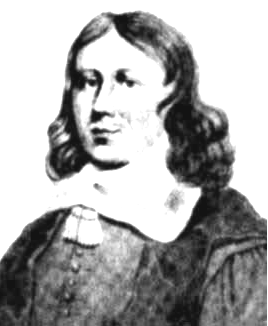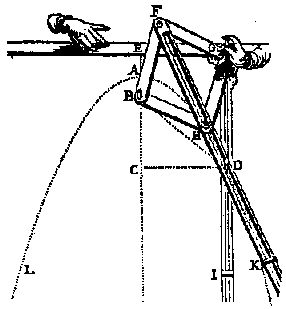- About MAA
- Membership
- MAA Publications
- Periodicals
- Blogs
- MAA Book Series
- MAA Press (an imprint of the AMS)
- MAA Notes
- MAA Reviews
- Mathematical Communication
- Information for Libraries
- Author Resources
- Advertise with MAA
- Meetings
- Competitions
- Programs
- Communities
- MAA Sections
- SIGMAA
- MAA Connect
- Students
- MAA Awards
- Awards Booklets
- Writing Awards
- Teaching Awards
- Service Awards
- Research Awards
- Lecture Awards
- Putnam Competition Individual and Team Winners
- D. E. Shaw Group AMC 8 Awards & Certificates
- Maryam Mirzakhani AMC 10 A Awards & Certificates
- Two Sigma AMC 10 B Awards & Certificates
- Jane Street AMC 12 A Awards & Certificates
- Akamai AMC 12 B Awards & Certificates
- High School Teachers
- News
You are here
Van Schooten's Ruler Constructions - Introduction
Editor's note: The article, "Van Schooten's Ruler Constructions," by C. Edward Sandifer, was originally published in the inaugural issue of Convergence in April of 2004. Ten years after its original appearance, in 2014, Convergence is pleased to restore and republish this article about the Dutch mathematician Frans van Schooten, his work in geometry, and how this work can be used in the classroom.
Introduction
Frans van Schooten (1615-1660) was one of those mathematicians on whose shoulders the giants stood. Perhaps none of van Schooten’s mathematics was truly original, yet he provided an essential link for at least four great and original mathematicians, François Vieté (1540-1603), René Descartes (1596-1650), Christian Huygens (1629-1695) and Isaac Newton (1643-1727).

Frans van Schooten (Source: Convergence Portrait Gallery)
Van Schooten was born, studied, worked and died in Leiden, Netherlands. There, in 1637, he met Descartes, who was visiting, and was thus introduced to the mathematical circle of Marin Mersenne. In 1643, he joined his father as an assistant professor in the engineering school at the University of Leiden and succeeded his father two years later. He held that post until his death in 1660.
During that career, van Schooten seems to have published four books. The first, and most forgettable, was a collection of trigonometric tables, published in 1645. This book, with the typically long 17th Century title, Table de sinus, tangentes et secantes ad radium 10,000,000 : Avec une methode de resoudre très-facilement par leur moyen tous les triangles rectilignes & spheriques, is a little unusual in that the title changes language from Latin to French halfway through. At the time, decimal fractions were not in wide use, so van Schooten’s tables were in the old style. They gave the measurements for the sine, tangent and secant on a circle of radius 10,000,000 rather than on a circle of radius 1, as we do today. Thus, the sin 90°, also called the “total sine” was given as 10,000,000, and the sine of 45° was 7,071,068 and not 0.7071068, as we would use today. Anyone using these tables would use rules of proportion to make any necessary conversions. Schooten probably wrote only the text that described how to use these tables, and the tables were probably just a reprint of tables that had already been published before.
Van Schooten’s first important book was his Collected Works of François Vieté, published in 1646. This made Vieté’s algebraic notations and techniques available to a wider audience, and also established van Schooten’s fame in the mathematical community.
Van Schooten is best known for translating Descartes’ Geometria into Latin and publishing it, with some commentaries. The first edition of this translation appeared in 1649, a year before Descartes’ death. It is said that Descartes opposed the project, but the copyright laws of the times did not allow him to prevent its publication. Descartes had written the Geometria as an appendix to his Discourse on the Method in 1638. It had been written in French. At the time, virtually all scholars could read and write Latin, but relatively few could read French, so Descartes’ groundbreaking work was not very widely available. Van Schooten’s Latin translation made Descartes’ Geometria available to a much wider scholarly audience, while his commentaries, along with those of Florimond DeBeaune, enabled people to understand and use Descartes’ often deliberately sketchy discoveries and ideas.
The 1649 edition of Descartes’ Geometria was so successful that van Schooten recruited three more distinguished commentators, Johann Hudde, Jan de Witt and Henri Heuraet and expanded the commentaries to two volumes, published in 1659 and 1661. Just five years later, a young Isaac Newton, who could read Latin but not French, read Hudde’s commentaries about methods for finding the slopes of lines tangent to curves. He worked pages and pages of examples before he came upon the general principles of differential and integral calculus and made all of Hudde’s work obsolete. Thus, van Schooten was the editor who carried Descartes’ ideas, through Hudde and others, to Isaac Newton, at almost exactly the time he needed those ideas to discover calculus.
Van Schooten’s commentaries on Descartes continued to be popular well after his death in 1660. There was a third edition, virtually identical to the second, published in 1683, and a fourth edition in 1694. The fourth edition included some new commentaries by Bernoulli.
Not all of van Schooten’s work was based on the works of others. Indeed, none of these three works, the tables, the collected works of Vieté, and the commentaries on Descartes, were very original, though they were quite important. However, between the first and second edition of the Descartes, van Schooten made his only foray into original work. In 1657, he published his Exercitationum mathematicarum libri quinque. As the title suggests, the work is divided into five “books” of about a hundred pages each.
Somehow, even in his master work, van Schooten arranged to be overshadowed by the work of others. Almost as an afterthought, van Schooten translated from Dutch an article by his student Christian Huygens. He included this as a 14-page appendix titled “De ratiocinis in ludo aleae.” As it turned out, this short article contained 14 propositions, the first theorems proved and published in the field of probability. These 14 pages by van Schooten’s student have proved far more important than the 520 pages that van Schooten himself wrote.
This is not to say the book itself is not interesting. In the next section, we provide an overview of van Schooten's Exercitationum mathematicarum libri quinque. For seven images from a copy of this text once owned by Hudde, see the Convergence article, "Mathematical Treasure: Frans van Schooten's Exercitationes mathematicae."

Parabola drawer from Book IV of van Schooten's Exercitationes mathematicae
Interested in using van Schooten's problems in your geometry class? Be sure to see Note to Teachers.
Next:
C. Edward Sandifer, "Van Schooten's Ruler Constructions - Introduction," Convergence (August 2010), DOI:10.4169/convergence20141101




